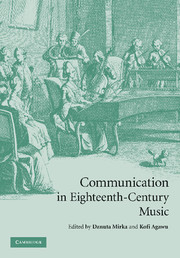Book contents
- Frontmatter
- Contents
- Notes on contributors
- Introduction
- Part I COMMUNICATION AND THE MARKET
- Part II MUSICAL GRAMMAR
- 4 Metre, phrase structure and manipulations of musical beginnings
- 5 National metrical types in music of the eighteenth and early nineteenth centuries
- 6 Schoenberg's ‘second melody’, or, ‘Meyer-ed’ in the bass
- Part III RHETORICAL FORM AND TOPICAL DECORUM
- Afterword
- Bibliography
- Index of concepts
- Index of names and works
6 - Schoenberg's ‘second melody’, or, ‘Meyer-ed’ in the bass
Published online by Cambridge University Press: 22 September 2009
- Frontmatter
- Contents
- Notes on contributors
- Introduction
- Part I COMMUNICATION AND THE MARKET
- Part II MUSICAL GRAMMAR
- 4 Metre, phrase structure and manipulations of musical beginnings
- 5 National metrical types in music of the eighteenth and early nineteenth centuries
- 6 Schoenberg's ‘second melody’, or, ‘Meyer-ed’ in the bass
- Part III RHETORICAL FORM AND TOPICAL DECORUM
- Afterword
- Bibliography
- Index of concepts
- Index of names and works
Summary
At the end of a chapter of his Fundamentals of Musical Composition entitled ‘Advice for Self Criticism’, Arnold Schoenberg admonishes the beginning composer to: ‘watch the harmony; watch the root progressions; watch the bass line’. It is no surprise that he would direct the composer to harmony and root motion, the bread and butter of compositional training. But striking is his highlighting of the bass part, in effect saying nothing about the upper voice, to which listeners normally direct their hearing. Indeed, most composition treatises – from Riepel and Koch in the eighteenth century, through Marx, Lobe and Riemann in the nineteenth – employ musical examples that mostly show the soprano melody alone, thus supposing that readers will intuit the bass line on their own. Yet Schoenberg wants to focus on the lowest voice of the musical texture; and in so doing, he taps into another important source of compositional pedagogy, one reflected, for example, by the numerous partimenti treatises produced throughout those same two centuries, works that provide stock bass lines for learning improvisation and composition.
Now what does Schoenberg actually want the composer to watch for in the bass line? Earlier in the chapter, he briefly explains:
The bass was previously described as a ‘second melody’. This means that it is subject to somewhat the same requirements as the principal melody. It should be rhythmically balanced, should avoid the monotony of unnecessary repetitions, should have some variety of contour and should make full use of inversions (especially of seventh chords).
- Type
- Chapter
- Information
- Communication in Eighteenth-Century Music , pp. 160 - 186Publisher: Cambridge University PressPrint publication year: 2008
- 9
- Cited by

